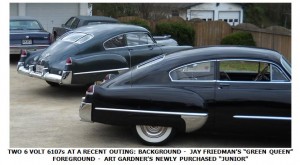A year or so ago Forty Niner Pete Hoffman and his 6107 moved from snowy upstate New York to sunny Southern California. (See the Sept. ’09 Times for a photo of Pete’s car) In the Golden State he not only drives the ’49 year round, but has had a series of successes which he recounted in a letter to the Times. Pete started off by saying “My ’49 has been doing great out here. It has six Best of Shows and one of them was outstanding. At a show in Orange County there were 425 cars. The ’49 took Best of Show and I was interviewed for Channel 6 News.” Next, echoing the article in the June ’11 Times on 8 volt batteries as a solution to 6 volt starting problems, Pete wrote: “I just changed the ’49 to an 8 volt battery and I am so happy with the results. It really spins the 331. I bought an 8 volt battery tender to keep it fully charged.”
Category Archives: Battery
IT WORKS FOR ME 8 VOLTS SOLVES THE 6 VOLT STARTING PROBLEMS
After reading the article in the March ’11 Times on 6 volt battery problems, I thought I’d share with everyone how I solved the problem. I put in an 8 volt battery. Everything stays the same. The voltage regulator is re-set to 8.6 volts, which is enough to do the job. All the bulbs are ok and when I tell her to start it sounds just like a 12 volt system. I had the same problem on a 1948 Lincoln V12 which 8 volts fixed. I’m sure there will be much controversy, but it works for me
IF YOU HAVE 6 VOLT STARTING PROBLEMS
When I first got my ’49, after running for a while on hot days, if I turned off the engine for 15-30 minutes it would frequently refuse to re-start. The starter would turn ever so slowly and the only way I could get the car going again would be to jump start it or let it to cool off. This is a common problem with 6 volt cars and, of course, always happens when admiring onlookers are standing around. I took the advice of the proprietor of an auto electric and improved my 6 volt system. This involved:
1. Installing a 6 volt battery with at least 600 cold cranking amps, which are readily available. 6 volt lead-acid batteries are sold by several manufacturers for less than $100, though authentic looking Delco batteries are more expensive. Mine is an “Optima”, which are now available at www.amazon.com for about $125. Optimas use a different technology than lead-acid batteries and have more than 800 cold cranking amps. An Optima’s downside is that it is much smaller in size than an ordinary 6 volt battery, so I had to fabricate a rectangular piece of plywood to go over its top and hold it down in the car’s battery box;
2. Having my starter re-built by an auto electric shop with heavy duty field coils and, to assure a good ground, removing all paint from the areas where the starter, its bolts and the flywheel housing meet;
3. Installing a custom-made extra-thick positive battery cable made up from 600 volt welding cable. Similar thick cables can be bought ready-made from McVey’s, The Brillman Company and Cole’s Ignition and Electric, Rochester NY;
4. Installing a brand new negative battery cable, after scraping clean the negative battery post, as well as the place on the frame and the starter bolt it is attached to. These can be bought from McVey’s and, I think, from Cole’s;
5. Making sure that the small ground straps from the back of the cylinder heads to bolts on the nearby firewall are in good shape. If not, new ones can be bought from McVey’s in Kansas and, I think, from Cole’s. As with the starter, scrape any paint off the cylinder head and firewall where these small straps mount.
After doing the above, when I press its button the starter jumps to attention and says “yes sir”, while onlookers, if any, applaud
More On Battery Cutoff Switch
More On Battery Cutoff Switch
Car Wont Start
Car Won’t Start
Fixing No Start Problem
Fixing No Start Problem
Dealing With Those Six Volt Blues
Dealing With Those Six Volt Blues
Check Your Battery
Check Your Battery
